Will Hummingbirds Visit a Feeder That Is Close to Other Feeders?

Hummingbirds are amazing to attract and easily come to feeders, if those feeders are in the right place. But where in your yard is the best place to hang nectar feeders for hungry hummingbirds?
Privacy Matters
Hummingbirds can be aggressive and territorial, gallantly defending their favorite feeding areas, including both nectar feeders as well as nectar-rich flowerbeds. Despite their bold personalities, however, hummingbirds can still be easily intimidated by larger birds, and it is never a good idea to position hummingbird feeders near seed or suet feeders that are popular with other birds. Even though larger birds – sparrows, finches, thrushes, titmice, etc. – may not be interested in the nectar, they will perch on feeder hooks or fly by the nectar feeder so closely that hummingbirds are uncomfortable. Larger birds may also spill the nectar as they land on the hummingbird feeder, and that spillage can attract more insects and other pests that will also frighten hummingbirds away.
In addition to privacy from other bird species, hummingbirds can also feed more comfortably if they have privacy from one another. While several small hummingbird feeders can be grouped together to create a larger feeding station, one hyper-aggressive hummer could dominate that feeding area and keep other, more timid hummingbirds from visiting. Instead, position hummingbird feeders at least 15-20 feet apart. Feeder placement will be even better if the nectar feeders are out of sight from one another, such as around a corner or on different sides of a large tree or shrubbery that will conceal feeding activities. Spreading several feeders throughout the yard will better invite more hummingbirds to enjoy the nectar while minimizing unwanted aggressive behavior from angry hummingbirds.
More Tips for Hummingbird Feeder Placement
To make the most of where you choose to put hummingbird feeders…
- Place feeders in a visible location where they will more easily catch hummingbirds' notice to attract more birds to discover the delicious treat. If feeders are hidden under deck or patio overhangs, hummingbirds may not see them as easily.
- Dappled shade locations are best to keep nectar cool and fresh but still show sparkles in the sun so birds notice the feeding area. While the direct sunlight would be very visible, the extra heat would also cause the nectar to spoil more quickly.
- Choose locations and heights where feeders are easy to access for cleaning and refilling so they can be kept in great condition. This will make it more convenient to take care of feeders properly so hummingbirds are safe without the risk of contaminated nectar.
- Position feeders either closer than 3 feet to glass or more than 10 feet away to minimize the risk of hummingbirds colliding dangerously with windows. This will give hummers plenty of maneuvering room to stay safe when flying near feeders.
- Avoid any locations where winds or cross breezes can get gusty, which could cause extra leaks and spillage, wasting nectar and attracting pests. Positioning feeders away from the busiest pathways will also keep them from getting bumped or jostled.
- If possible, position nectar feeders near rich, natural food sources such as burgeoning flowerbeds that will draw birds in easily. Colorful flowerbeds or accents such as gazing balls will also attract more hummingbirds.
- Hang hummingbird feeders in areas where there are natural perches for hungry hummers to rest between sweet sips, or add hummingbird swings or other perches nearby. This gives the birds a place to rest and watch over their favorite feeders.
Hummingbirds may seem bold and feisty, but they can be surprisingly picky about where their feeders are positioned. By taking into account their preferences for privacy, their natural aggression to protect a favorite feeding spot and other considerations to create the best possible feeding station, you can hang your hummingbird feeders in just the right locations to attract more hummingbirds and offer each of them a tasty meal.
